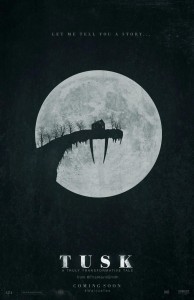Tusk
Posted on September 18, 2014 at 5:59 pm

You can make a good movie about slackers, for example “Slackers,” from Richard Linklater and “Clerks” from Kevin Smith. But you can’t make a good movie by a slacker, and Smith does not seem willing to be anything more. There are flickers of interesting possibilities in his latest film, his first foray into horror. Justin Long nails his early scenes as Wallace, a sort of Smith wannabe. We learn later in flashbacks that he was once a sweet, geeky guy who cried in “Winnie the Pooh.” He was conversant enough with literature to recognize quotes from “The Rime of the Ancient Mariner” and Hemingway. But he found out he could make money and attract groupies by being obnoxious and outrageous. Wallace and his best friend Teddy (Haley Joel Osment) host a podcast something between Smith’s own SModcast, Tosh.0 and the skankier sub-reddits. It’s called “Not-See Party,” get it? In case you don’t, Wallace has a sign-off in a fake German accent. What, too soon?
We first see them helpless with laughter over a found video along the lines of the “Star Wars kid,” but this one is a “Kill Bill” wannabe who accidentally slices off his own leg at the thigh. A real laff-riot! This is such a bonanza of a topic for the Not-See Party duo that Wallace decides to visit the kid in person, at his home in Manitoba, Canada. But when he gets there (following a not-funny encounter at the border with an official who warns him not to be flippant about hockey in Canada), Wallace discovers that the despondent kid has committed suicide. Bummer for the podcast! Seeking some other poor slob to make fun of so the trip won’t be wasted, Wallace comes across an intriguing flier in a men’s room, a man named Howard Howe, a retired sailor, who says he has stories to tell. Wallace rents a car and drives two hours into Howard’s remote house (beautifully creepy interiors by John D. Kretschmer, a highlight of the film). He sips at the tea offered to him by the genially eloquent Howard (as he prefers to be called), at first condescending but thinly disguising his snark, then impressed in spite of himself with Howard’s stories of WWII and being shipwrecked, and then, suddenly, very, very, very, very sleepy.
The tea was spiked. Howard has something very gruesome in mind, which we discover along with the terrified Wallace.
The idea for this film came up in a SModcast conversation with Smith and friend and producer Scott Mosier discussing an ad placed by a homeowner who was offering a living situation free of charge, if the lodger would agree to dress as a walrus. Their can-you-top-this riffs on the possibilities suggested by the ad led to a twitter campaign with the hashtag #walrusyes. And that is why it feels at times as though the screenplay was pieced together by tweets. A major Hollywood star shows up in disguise for a stunt-ish, winking-at-the-screen turn as a Quebecois detective in pursuit of Howard Howe, not nearly as funny or charming as intended. While there are hints of something deeper — the conversation about how Wallace as devolved as a person, with his girlfriend missing the “old Wallace,” the similarities between “Wallace” and “Walrus” — the real possibilities of the storyline about humanity, inhumanity, and what separates us from the animals, are blithely bypassed for random detours and red herrings (maybe red mackerels). It is another disappointment from Smith, who may not write all of his scripts while stoned, but they sure feel like it.
Parents should know that this is a horror film with many graphic and disturbing images of torture and mutilation. Characters are injured and killed. It also includes strong language, drinking and smoking, and sexual references and situations, with brief male rear nudity.
Family discussion: Are we supposed to think that Wallace somehow deserved or asked for what happened to him? How do you interpret the final scene?
If you like this, try: “The Skin I Live In” and “Boxing Helena” — and Eugene Ionesco’s classic Rhinoceros
